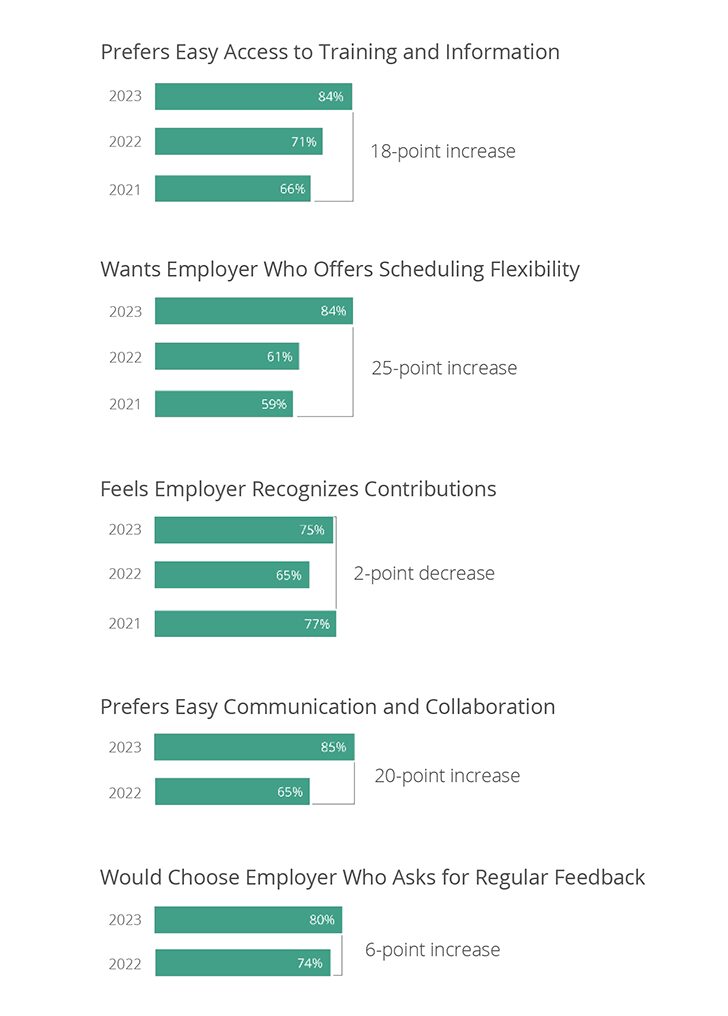Over the past three years, our primary research into the deskless employee experience has revealed distinct gaps between employee and employer perspectives on delivering capabilities that create quality work experiences. The findings of our Third Global Employee Experience Study reveal that, since our first report in 2021, the perception gap between these two groups on key employee experience aspects has shrunk dramatically.
In the previous article in this series, we’ve discussed this growing alignment and how it represents a significant shift as employers and employees increasingly recognize these experience elements as fundamental. The results also reveal the importance of flexible scheduling, job training, work communications, employee feedback, and employee recognition to employees.
While various factors contribute to this shift, it’s important to acknowledge that these are not fleeting trends but substantive changes in what employees prioritize. With the acknowledgment of the criticality of employee experience, organizations must swiftly respond by implementing actions that effectively tackle the root causes of employee dissatisfaction.
The following is a recap of some key points from an article by Sandra Moran, Chief Marketing and Client Experience Officer at WorkForce Software, published on LinkedIn.
The Growing Importance of Experience in the Eyes of Employees
The insights from three years of research reveal how key areas of experience are trending with frontline employees:

These findings indicate that employees have clear expectations from employers, including their preferred workplace. This serves as an urgent call to action for employers to prioritize investments to enhance the identified experience challenges. Addressing issues that resonate with employees not only holds intrinsic value but also yields tangible business benefits, such as improved retention rates, increased productivity, and heightened client satisfaction.
Flexible Scheduling is Here to Stay
- Because both office-based employees and front-line workers now prioritize flexible working arrangements, scheduling flexibility has become table stakes for employers, offering their employees greater autonomy over their work-life balance.
- The absence of modern scheduling options may prompt employees to seek opportunities elsewhere, emphasizing the importance of providing such amenities.
- Employees are increasingly willing to explore opportunities elsewhere if their current employer doesn’t offer these options.
Job Mobility in an Evolving Labor Market
- While 2024’s labor market shows signs of stabilization, turnover rates persist, especially in the private sector.
- Our Global Employee Experience Study revealed that 60% of employees are open to changing jobs within the next six months, rising to 73% among those dissatisfied with their current positions.
- The current landscape reflects a workforce seeking employers who actively support their holistic welfare, driving job mobility even in stable economic conditions.
The Demand for Mobile Access to Work Information
- Despite the seamless access to information in our personal lives, many employees encounter frustration due to the lack of similar accessibility in the workplace.
- Our survey findings reveal a notable preference among both employees (55%) and managers (59%) for mobile access to training and job information.
- However, only 22% of respondents report having access to mobile options at work, highlighting a significant gap between preference and availability.
- Addressing this gap presents an opportunity to enhance both productivity and employee satisfaction by leveraging mobile technology for better information access in the workplace.
Employees have spoken and their priorities are clear—flexible scheduling, accessible training, open communication, and meaningful recognition. Businesses can not only bridge the experience gap but also unlock employee satisfaction, retention, and productivity. The findings of our Third Annual Employee Experience Study offer actionable insights for large organizations seeking to meet the demands for enhanced employee experiences. It’s evident that the availability of improvements in employee experience will significantly impact the preferences of deskless workers when selecting their place of employment.
This blog is a recap of an article originally published on LinkedIn by Sandra Moran. Read the full article, Adapting to Increasing Workforce Experience Expectations to learn more about Sandra’s insights.




